Abstract
The current study investigates the association of board characteristics with firms’ environmental performance to provide further research and policy implications by carrying out systematic bibliometric analysis. The most potent contribution of the current study was to evaluate the performance of authors, geographical regions, journals and academic institutions to document their impact on the development of current literature. Moreover, the current study has used analytical statistics to examine how current research themes have evolved, and how impediments in existing literature can be overcome. Our analysis allows us to conclude that there is a lack of research collaboration between researchers and institutions in developing and developed countries. Finally, we summarize that the economic literature focuses more on BOD diversity, and there is less focus on theoretical development; non-listed firms, geographical proximity and mediating variables are research areas that need further academic attention. We conclude the current research investigation by identifying new research avenues.
1. Introduction and Literature Review
Recent environmental literature has provided great evidence about how the corporate world should overcome concerns about social and environmental performances [1,2,3,4]. As a result, a growing number of researchers [5,6,7] have promoted the concept of ‘green strategies’ to overcome environmental degradation [8], foster energy investments’ efficiency [9,10,11] and lay the foundation for long-term environmental sustainability [12]. Moreover, communal and governmental pressure has escalated, forcing top-management teams to improve environmental performance [13]. In these ever-changing dynamics, the functional departments within large-scale firms have made efforts to ‘re-conceptualize’ the organizational missions to comply with sustainable objectives [14]. Consequently, the shift to adopt social and environmental responsibilities requires transformation in human resources, the CEO, and most importantly board of directors [15]. Thus, the wider spectrum of accommodating and satisfying the interests of various stakeholders means that BODs face a diverse set of duties and challenges [16,17]. Among these challenges, adopting environmental sustainability initiatives, transparency in environmental disclosure and endorsing ethical behaviors have been identified as the most influential environmental indicators.
Our analysis of current economic literature highlights that BOD structure is key in advancing toward social and environmental goals, as it influences monetary and non-monetary objectives [18]. The latter directly impacts board’s credibility, firm valuation and risk assessment by investors [19]. To achieve this, the BOD’s primary responsibility has shifted from balancing stakeholders’ and shareholders’ interests to also adopting systematic tactics toward implementing sustainability initiatives [20]. This would add new dynamics to BOD characteristics in aligning sustainability commitments, responsiveness to the general public and business effectiveness. In summary, pursuing environmental regulations may affect profit margins, but it is coming under growing scrutiny as organizations aim to pursue UN SDGs [21,22,23,24]. This discussion allows us to define firms’ environmental performance as a complex nested system that integrates economic, social and environmental indicators, to provide greater disclosure about firms’ energy, carbon and ecological footprint. An accurate account of board characteristics’ influence on the above-mentioned sub-components will help devise policy mechanisms towards carbon reduction strategies, renewable deployment and greening production processes in the long run [25]. Moreover, improving environmental performance will strengthening policy making institutions to introduce sustainable economic changes in developing and developed economies. Although several studies have provided significant evidence in recent times about BOD composition and firm performance [26,27,28], little attention has been given to how board composition, i.e., board gender diversity, deters or facilitates firms’ environmental performances [29]. As a result, current research has focused on investigating economic literature regarding BODs’ characteristics associated with environmental performances to outline limitations in the existing research and provide new research directions for future studies. We chose bibliometric analysis to identify intellectual structure and publication patterns in the economic literature. The current study is the foremost one to comprehensively evaluate how gender diversity impacts the performance of environmental firms through bibliometric analysis [30,31]. Our research is based on several research areas: citations and publications trends (RQ1); journals with most publications (RQ2); most influential research publications (RQ3); widely used keywords (RQ4); contribution of institutions and authors (RQ5); degree of research collaboration (RQ6); intellectual structure of academic contribution (RQ7); co-occurrence network (RQ8); research themes (RQ9); and impediments in development of scientific literature and future research directions (RQ11).
It is our opinion that studies of Terjesen et al. [32] and Kagzi and Guha [33] were mainly limited to board diversity and firm performance content analysis, while Velte [34] evaluated the impact of gender diversity over firm performance through systematic literature review. Keeping the above-mentioned discussion in mind, we provide a novel research contribution in the following ways: first, no previous study has used a bibliometric approach to analyze how board composition affects firm performance; second, except Terjesen et al. [32], earlier studies have relied on a more limited data period that our study; third, our detailed approach of analyzing research publications through research questions not only helps evaluate current literature [35], but also how future research can be improved.
2. Bibliometric Analysis
To begin with, the current study has chosen to follow the bibliometric process (Figure 1) suggested by Bashir [36,37], where the main emphasis is on to use scheme of study, data collection and bibliometric analytical software to visualize and interpret findings from the analysis.
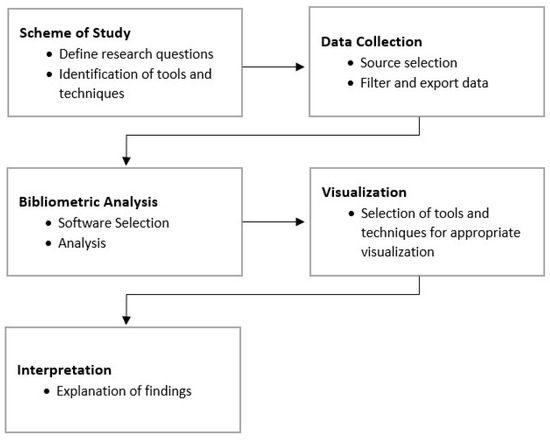
Figure 1.
Main analytical procedure for bibliometrics analysis.
2.1. Scheme of Study
In view of recent corporate reforms aimed at providing greater focus on the impact of BOD characteristics on firms’ environmental performances, we have used an analytical approach to identify major academic influences regarding publication sources, researchers, countries and research institutions through source impact, annual publications and number of citations. Additionally, we divide core sources through Bradford’s law into three zones, where zone 1 contains sources with most while zone 3 has least influential sources [36,37]. Our approach also allows us to study evolution of research themes through co-occurrence and thematic map methodologies [38,39]. Furthermore, we study knowledge structure and association between cross-research areas through keywords plus analysis [40] to express scientific content in a meaningful way.
2.2. Research Objectives and Analytical Techniques
The main purpose of this article is to attempt to use a systematic literature review as empirical effort to study how BOD diversity, influenced by institutional and regulatory reforms [29,41], impacts firms’ environmental performance and provides policy suggestions. For this, we have further divided our research agendas to create better understanding. Our first objective is to use R package to identify the main research contributions from authors, institutions, publications and authors. Moreover, the use of co-citation and co-occurrence allows us to help identify limitations in current literature through analytical review.
2.3. Selection of Dataset
For bibliometric analysis, we follow a two-tiered approach, where first we chose WOS (Web of Science) database to select scientific publications. Next, the authors formulated search queries to select optimal findings.
The final search query consists of “board diversity” and “firm” and “environmental performance” and “female directors” and “environmental assessment” and “BOD diversity” and “sustainability disclosure” and “board diversity” and “environmental sustainability”. The search query initially provided 315 articles, with English publication considered for sample selection. Lastly, we refined article selection according to PRISMA guidelines to arrive at a final sample of 117 publications.
3. Bibliometric Analysis and Visualization
As mentioned earlier, we have used the R package as the main analytical tool to provide scientometric findings related to academic journals, documents, researchers, social, intellectual and conceptual structure of 117 studies. Moreover, the R package provides distinct bibliometric features from other analytical tools available for bibliometric analysis.
The descriptive statistics for BOD gender diversity are provided in Table 1, where there is more emphasis on research collaboration than single-author publications. The statistics of 0.296 for author per document that more than two authors contributed to the publication of a single research item.

Table 1.
Descriptive Statistics.
Next, we analyze the trend of per-year publications and citations, which can be examined in Figure 2. Though the literature on the topic at hand is at an elementary stage, we can observe that there has been significant growth from 2019 onwards. The trend in citation growth has a similar tendency, which indicates that the topic at hand will contribute to economic literature development.
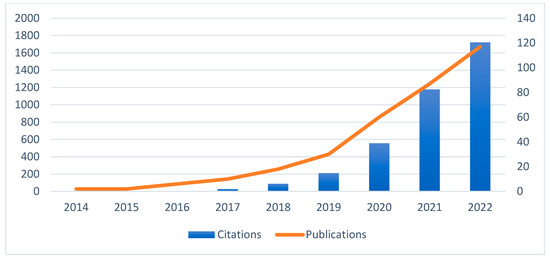
Figure 2.
Cumulative Publications and Citations Trend.
Figure 3 helps further analysis by providing a graphical illustration of the interaction between key terms, academic journals and countries with the highest production regarding research related to board characteristics and firms’ environmental performance. This allows us to observe that gender diversity, corporate social responsibility, board gender diversity and sustainability reporting are the research focal points where China, Pakistan, Spain and Italy have accounted for the highest research output.
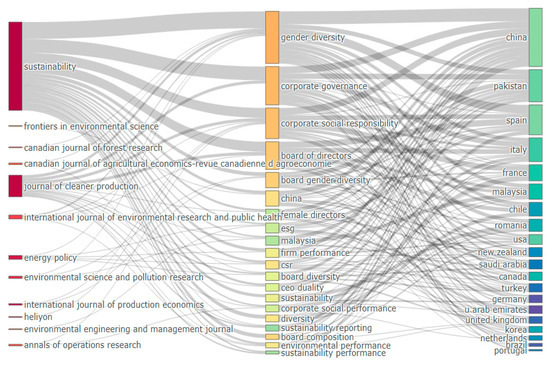
Figure 3.
Three field analysis of BOD diversity and firms’ environmental performance.
3.1. Influential Aspects of Board Diversity Literature
3.1.1. Most Influential Research Journals
Next, the researchers used Bradford’s law and source impact to document the impact of academic journals on the theoretical development of scientific literature. We use Table 2 to list journals on total publications and citations, whereas, Table 3 provides detailed information for classifications under Bradford’s law into Zone 1, Zone 2 and Zone 3 with journals with highest research impact being reported in Zone 1.

Table 2.
Top 10 journals according to source impact.

Table 3.
Journal Rankings (Bradford’s law).
Sustainability is the most dominant journal and has researched areas such as board composition and CSR reporting, the role of women directors in CSR and how board composition affects ESG performance. The Impact of Supervisory Board Composition on CSR Reporting. Evidence from the German Two-Tier System [42] is the most cited article published in Sustainability, where researchers investigated the German two-tiered system to reveal that gender diversity, and supervisory boards have a positive correlation with CSR disclosure intensity. The researchers further implied that such findings would allow governance regulations in EU economies to provide further meaningfulness to CSR reporting standards. Women on Boards and Corporate Social Responsibility [43] collected data from S&P 1500 firms indexed to document those strong moral orientations that allow female directors to be more assertive towards improving CSR performance. Composition and Activity of the Board of Directors: Impact on ESG Performance in the Banking System [44] empirically evaluated the impact of female directors on environmental, social and governance performances. The study used fixed panel regression approach to show that only gender-balanced BODs positively correlate with sustainability performance. Journal of Cleaner Production is the second most influential journal and has published research related to firms’ sustainability performance, the association between board gender diversity and sustainability practices, corporate social responsibility committees and green governance. Corporate governance and board of directors: The effect of board composition on firm sustainability performance [45] researched corporate compliance with sustainable development goals by analyzing how board gender diversity sustainability practices. The researchers collected data from 362 firms from 46 emerging and developed economies; higher diversity in BODs yield higher sustainability performances. Boardroom gender diversity and corporate sustainability practices: Evidence from Australian Securities Exchange listed firms [46] evaluated the regulatory impact of corporate reforms in Australian companies’ corporate sustainability reporting standards through GMM, by sampling data from the Australian Securities Exchange. The empirical findings highlighted that the presence of female directors oversaw marked improvement in compliance with sustainability practices. Lastly, another key study was Boardroom gender diversity: Implications for corporate sustainability disclosures in Malaysia [47], which focused on sustainability practices after introducing the Malaysian Code on Corporate Governance. The study used Ordinary Least Squares as a statistical approach to suggest that firms with female directors are more inclined to comply with corporate sustainability disclosures in Malaysia. Lastly, the International Journal of Production Economics is another journal that has published studies on drivers of CSR performances, CSR strategies and eco-friendly initiatives. Drivers and value-relevance of CSR performance in the logistics sector: A cross-country firm-level investigation [48] published the most significant study, where the researchers’ evaluated drivers of CSR performances through the novel composite score by focusing on the impact of board characteristics in the logistics sector. By sampling data from 2011 and 2018, the empirical evidence confirmed positive association between governance performance, corporate social responsibility performance and board gender diversity, as the female presence on CSR committees and BODs is the most integral indicator of compliance with environmental sustainability regulations.
Next, we document the annual scientific production of the top five journals through Figure 4. Sustainability is the primary source of BOD diversity and firms’ environmental diversity literature. Journal of Cleaner Production and the International journal of production economics have played a critical role in developing academic literature. These research trends would not only allow us to understand scientific trends and limitations of current studies but can be used to introduce relevant policy changes to further the firm performance as well.
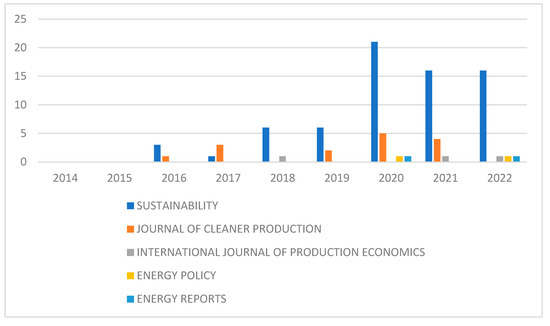
Figure 4.
Annual Publication trend in top journals.
3.1.2. Core Research Publications
Next, we document the impact of the top 15 scientific publications, where Table 4 provides statistics for local and global citations. Local citations study how much an article has been cited within the sample size, while global citations narrate the overall citation trend. Boardroom gender diversity and corporate sustainability practices: Evidence from Australian Securities Exchange listed firms [46] is the most significant study according to local citations, where GMM was used to evaluate data from firm-level data from the Australian Securities Exchange to document that proportion of female directors has significant influence over the introduction and timely compliance with sustainability practices in Australian firms. Corporate governance and board of directors: The effect of board composition on firm sustainability performance [45] is the second-ranked study based on our criteria, where the author claimed that firms are under increasing pressure from stakeholders to attempt to overcome sustainability-related issues. The empirical approach of the study allowed the researchers to conclude that board composition structures significantly influence stainability performance, as the separation of CEO and board chair and board diversity result in higher environmental performance by corporations. Women on Boards and Corporate Social Responsibility [43] attempted to bridge the research gap in current literature by evaluating firms’ CSR and the presence of female directors and identifying the context where female directors can lead to higher CSR performances. The empirical evidence allowed the researchers to conclude that moral orientations and reputational reasons are the main reasons which ensure a strong positive association between CSR issues and female independent directors. Lastly, Does Corporate Social Responsibility Mediate the Relation between Boardroom Gender Diversity and Firm Performance of Chinese Listed Companies? [49] used OLS and 2SLS to test 2008 to 2015 to show that firm performance is significantly correlated with board diversity, which is moderated by CSR in the long run.

Table 4.
Most Locally and Globally Cited Papers.
3.1.3. Core Words
We further our analysis by detailing keywords analysis through Table 5. Corporate, gender and governance are the most dominant keywords. Meanwhile, sustainability, CSR and women directors have a presence in all categories. The extent of such keywords not only documents keywords related to gender, women, diversity, performance and corporate governance, which in recent times have been aimed at increasing BOD diversity but also how they impact firms’ environmental performance and CSR. Our approach allows us to conclude that scientific literature has a lesser focus on author keywords, while basic economic literature is covered by Keywords plus. Furthermore, recent studies indicate that recent corporate reforms aim to increase gender diversity within business corporations. Corporate, gender and performance are the most frequent keywords within the categories of titles and abstracts.

Table 5.
Most Frequent Keywords.
Figure 5 shows the word cloud generated on the basis of frequent author keywords, where a higher size indicates higher frequency. Board of directors and board gender diversity have the highest frequency, as the recent corporate governance reforms have been aimed at establishing more diverse boards. Moreover, there has been particular emphasis on corporate sustainability performance, sustainability, and sustainability and female directors, which have been researched to explore how female directors can influence the outcome of firm-level sustainability initiatives. A small portion of the literature has also attempted to investigate climate-related issues; hence keywords of climate change, female executives and sustainable development goals have researched the role of female corporate leaders in long-term environmental sustainability. Finally, female directors, CSR committees and social sustainability have a prominent frequency as to how change in corporate board structures leads to better social responsibility and participation in environmental sustainability. In general, all the keywords (Figure 5) study board structures, board gender diversity and environmental sustainability, and researchers can follow this better to integrate corporate and environmental research in the future.
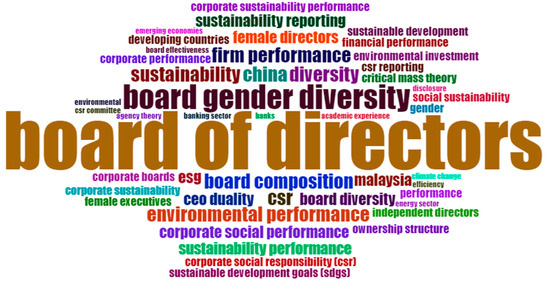
Figure 5.
Word Cloud.
We also evaluate the frequency of the most common keywords. Figure 6 help us understand that gender diversity, corporate governance and corporate social responsibility have been the most popular research keywords used by researchers to integrate board diversity within environmental literature. Other keywords such as board gender diversity, board composition, China and environmental performance examine how board gender diversity has impacted firms’ environmental performance in emerging economies such as China.
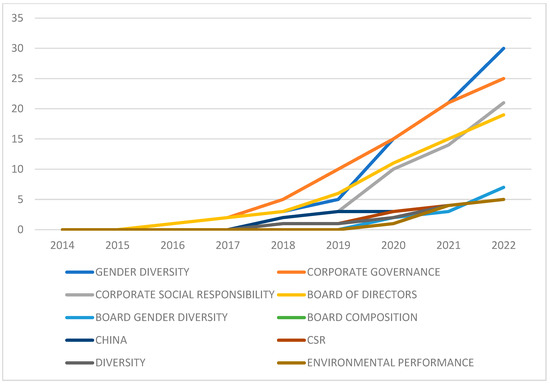
Figure 6.
Word Growth over time.
3.1.4. Main Researchers, Research Institutions and Countries
To further the study, we examine which countries, research institutions and researchers have had the most impact on scientific output. We first report the most dominant researchers (Table 6) by using the h-index and the number of articles published as standard criteria. Sial MS has played the most critical role in the development of academic discussion with a primary research focus on CSR, board diversity and CSR reporting. The significant publication [50] researched the impact of foreign institutional investors and board gender diversity on CSR engagement of Chinese listed companies. Empirical dataset from CSMAR data source allowed the study to conclude that a higher presence of female directors and the active role of institutional investors in firms listed in the Shanghai and Shenzhen stock markets allows firms to have a tendency towards CSR reporting. Ali W is the second most influential author with a particular research interest in determinants of corporate sustainability disclosures. The most authentic study [47] examined the impact of the Malaysian code of corporate governance on sustainability practices in Malaysia. The empirical findings from the extensive empirical analysis suggest that firms with female directors are more inclined to comply with sustainability disclosures. Cherian J is the third most cited researcher, whose most cited study [49] evaluated how board diversity affects corporate social responsibility in data from Chinese firms and suggested that CSR mediated the association between firm performance and board gender diversity; the study to implies that the presence of female directors not only results in higher sustainable disclosures but also improves firms’ performance. Lastly, Fernandez-Torres, Gutierrez-Fernandez and Gallego-Sosa have played an active role in the development of academic research.

Table 6.
Top 10 Authors.
Next, we shift our attention towards the research output of individual countries and research collaboration between different geographical locations (Table 7), with statistical ranking based on total publications and total citations. China, Spain, the USA, Italy, South Korea, Pakistan and France appear in both rankings of publications and citations. Meanwhile, Romania, Chile and Canada appear in the list of publications only, and New Zealand, Germany and Australia are represented in the category of citations only.

Table 7.
Countries with the most publications and citations.
We also articulate the performance of individual research institutions (Figure 7) as they are integral to developing the overall research direction. Comsats University Islamabad has dominated the research field during the initial development of academic literature. Next on the list is Abu Dhabi University, American University of the Middle East, and Universidad de Extremadura are the joint second-ranked research institutions. Our analysis allows us to conclude that there is a growing focus on assessing how gender diversity impacts firms’ environmental performance, as research collaboration is integral in strengthening the foundations of new research horizons.
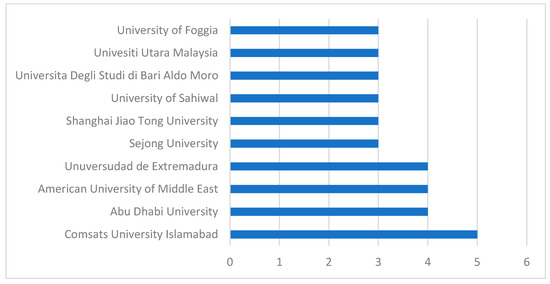
Figure 7.
Most relevant research institutions.
Next, we report our findings about publications from the corresponding authors’ points of view by providing details about single-author and multi-author publications. Table 8 allows us to infer that China has produced 22 publications, where half the publications belong to individual authors, showing a higher emphasis on research by individual researchers. Spain, the USA, Italy, Korea, Pakistan and Romania are the countries with most scientific literature. Lastly, Romania is the only country that has reported just 6% of academic contribution through multi-authored studies. This indicates how research collaboration must be established further to strengthen the cornerstone of academic and individual research.

Table 8.
List of countries (most corresponding authors).
The issue of board diversity is one of most critical issue in promoting gender equality; hence, promoting research contribution between researchers will not only help to overcome current issues faced by women in the corporate sector, but also to identify limitations in the existing research. Our findings in Table 9 report China and Pakistan have conducted most joint research projects, whereas academic collaboration between China and USA and Malaysia and Saudi Arabia have also yielded significant scientific contributions. To be precise, research from China, Pakistan and UAE has played the most significant role in research activities than other geographical regions. We also provide Figure 8 to highlight research collaboration between different countries, where darker color means higher research collaboration.

Table 9.
Collaboration Network.

Figure 8.
Countries with most research collaboration.
3.2. Conceptual Framework
To further the research, we use bi-dimensional matrix and co-occurrence network to examine the existence of various research streams within economic literature, which would allow to show centrality and density of the existing network analysis.
3.2.1. Co-Citation Analysis
We begin with co-citation analysis, which according to Small [51] is classified as “the number of times two articles are cited together”, to identify intellectual structure within selected studies [52]; this would allow us to reveal how economic literature has developed in recent years [53]. In the current study, we classify the citation of different papers within the same document as belonging to the same category [54]. Recent publications have relied on clustering to help identify research patterns (Figure 9) within research publications [55].
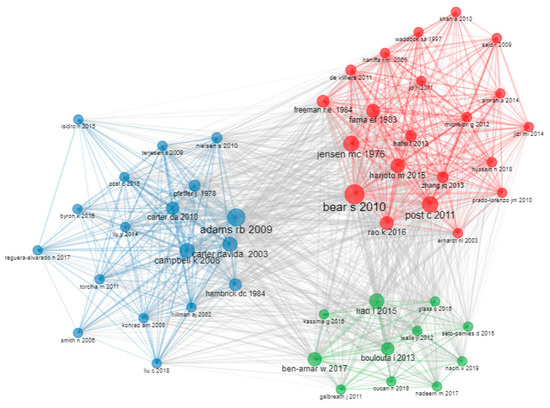
Figure 9.
Co-Citation Analysis.
3.2.2. Content Analysis
The co-citation analysis by current study allows researchers to divide selected studies into three main clusters (Figure 9). We extend this analysis by detailing prevailing research themes within these clusters. For this, we adopt the selection of top-10 research publications from all clusters as these publications have greater influence over the theoretical developments in the scientific literature [56].
Cluster 1 (BLUE): Board Diversity and the Firm Performance
Cluster 1 is the most dominant cluster, with an emphasis on identifying the research association between firm performance, compliance with governance mechanisms and the role of gender and ethnic diversity. The most dominant cited articles in this cluster have attempted to explore the impact of board diversity on firm financial performance [57], firm value and firm financial performance [58], and how board diversity impacts firm financial performance [59]. Another sub-cluster researched the role of gender and ethnic diversity to study the impact of women and racial minorities [60], and gender and ethnic board diversity and firm performance [61]. Lastly, another group of studies explored how board diversity influences firm governance and performance and how diversity in top management affects long-term firm performance [62].
Cluster 2 (Red): Board Diversity, CSR and Quality of Sustainability Reporting
Cluster 2 contains the most dominant studies which have established the correlation between board gender diversity, CSR and sustainability reporting; hence, contributing to the expansion of existing economic literature. Among these studies, some have documented board gender composition and CSR [63], CSR, board diversity and decision making [64] and green governance [65]. Another set of studies researched how board diversity impacts the quality of sustainability reporting [66] and the extent of sustainability disclosure [67].
Cluster 3 (Green): Board Diversity and Firms’ Environmental Performance
Cluster 3 is the smallest, though it is the most dominant in recent studies as it has explained how board diversity impacts firms’ environmental performances. Several studies have discussed how board diversity impacts environmental and sustainability practices by exploring board diversity, GHG disclosures and environmental committees [68], women directors and corporate sustainability [69] and approach towards compliance with corporate sustainability practices [46]. Lastly, some studies provided details about how board diversity impacts actual environmental performance by detailing how women leaders promote environmental sustainability [70] and board compositions’ correlation with firm sustainability performance [45]. Literature cited in the current cluster has extended the academic discussion by narrating how women directors have ensured higher compliance with environmental practices under recent changes in environmental regulations.
3.3. Co-Occurrence Network
Figure 10, extracted from R-Package, shows the co-occurrence network for the current study, which classifies the selected dataset into four distinct themes where the red cluster has the highest centrality with research interests aligning the impact of board gender diversity with multi-factors such as CSR, environmental performance, firm financial performance and the role of female executives in sustainability practices. This research direction has allowed the researchers to explore the multi-dimensional impact of board diversity on firms’ environmental and financial performances. Next, the blue cluster establishes the link between corporate governance, sustainability, CSR, CEO duality, sustainability performance, female directors, environmental investment and the research stream is titled corporate governance and sustainability performance. The modern approach to adopt sustainability goals is critical in evaluating carbon and environmental performances. Hence, higher investment in these initiatives will increase the effectiveness of environmental policies. The green cluster focuses on the research stream of impact of independent directors in emerging economies; it has high significance as the share of independent and female executives pushes firms to strive towards long-term environmental sustainability. Lastly, the magenta cluster is isolated, and has researched how board diversity affects corporate sustainability performances in the long run. Both factors have great significance in not only overseeing firm performance but also integrating corporate governance initiatives with firm policy making. We also use Table 10 to provide details about most common keywords in each cluster.
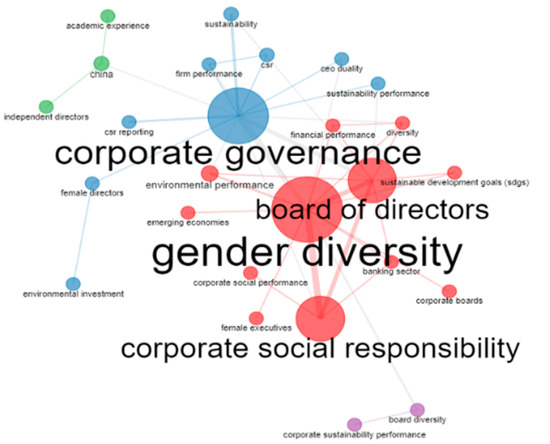
Figure 10.
Co-occurrence network.

Table 10.
Co-Occurrence Network: Keywords in Each Cluster.
3.4. Thematic Map
In an extension of the systematic review, we use thematic map to highlight how various research themes have influenced current literature. Figure 11 is the illustration of the thematic map, where development of research themes has been identified through density and centrality of the most dominant research content. We classify research themes into the following major categories: The lower left section portrays themes which are either emerging or declining within scientific studies, while basic themes have been highlighted in the lower right section which has low density but higher centrality than other research themes. We conclude that such research themes require additional attention from academicians. Next, highly developed research themes have been displayed in the upper left section that have higher density but lower centrality. Lastly, the research themes with higher density and centrality have been placed in the upper right section, as these research themes are essential in scientific literature. To arrive at conclusive findings, current research has limited the keyword frequency and representation label to five and three, respectively. It is our subjective judgement that this would help us identify the basic dynamics within literature.
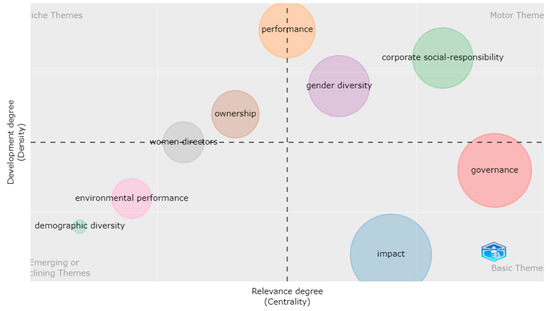
Figure 11.
Thematic Map.
We use Figure 12 to construct Table 11. The first cluster is represented by impact; this is a transversal and emerging theme and includes research areas of women, firm performance, directors, diversity, sustainability, and corporate governance. This is perhaps the most unique, as it has established essential association between the role of women directors within firms’ decision making as well as environmental and sustainability targets. The second research theme in this cluster is represented by corporate governance; with research focus on how gender diversity’s association with corporate governance has helped identify determinants of firm initiatives towards CSR, environmental disclosures and accepting social responsibilities. This not only affects firm performance and firm value, but also positively impacts different stakeholders. Next, we have identified environmental performance as part of an emerging theme, which has investigated research with a particular focus on how board and CEO characteristics correlate with environmental performance and corporate social responsibility in the long run. Another emerging theme is the topic of demographic diversity, which has discussed organization and top management team characteristics to increase diversity not only in firms’ decision making but also how this decision making complies with environmental sustainability in developed and developing economies.

Figure 12.
Thematic Evolution.

Table 11.
Thematic maps: keywords and themes.
The current study has identified corporate social responsibility as the motor theme with a main research focus on corporate social responsibility, management and representation of female directors, which not only affects decision making towards environmental initiatives, but also how such information can be communicated with relevant stakeholders in general. The second motor theme identified by the researchers is gender diversity with a research focus on the correlation between gender diversity, firms’ financial performance and sustainable development. This research area has significant room for growth as the scope of gender diversity under current reform initiatives has diverse impact that includes firms’ efforts to create a balance between environmental and financial goals. Lastly, ownership is a highly developed, yet isolated, research theme due to its higher density and lower centrality; it will be critical in the development of scientific topics of how institutional and independent directors can help push firms’ boards to be more diverse and use mechanisms such as audit committees to provide details about the impact of voluntary environmental disclosures. Finally, the last strand of highly developed and isolated themes focusses on the issues of performance and women directors, where stakeholder theory, strategy and firm leadership affects women’s representation in board composition, top management and environmental disclosure. These topics have the potential to explore the board diversity from an analytical approach and will be critical in overcoming the limitations of existing environmental literature.
3.5. Thematic Evolution
In a further extension, we rely on R package to study how research themes have developed into new research themes (Figure 12) to document how research topics were published by classifying before and after 2020. It is evident from Figure 12 that development of theoretical and analytical contributions, as well as research collaboration between academicians and researchers, have contributed to significant evolution of research themes in recent years. The first major academic interest of ‘governance’ has transformed into corporate social responsibility. This aligns with influential studies in the literature because corporate governance reforms in recent years have been pushed to create more diverse BODs to urge firms to accept social responsibility and comply with sustainable development under various environmental goals. The next major research themes of ‘disclosure’ and ‘performance’ have been transformed into CSR, management and women to establish how strong female representation in BODs allows firms to achieve higher performance in CSR and have better context to corporate decision making. Next, ‘firm performance’ and ‘impact’ has transformed into women, governance, management and empirical evidence, as more and more researchers have attempted to provide analytical evidence between board diversity and firms’ alignment with environmental initiatives. Lastly, ‘financial performance’ and ‘gender diversity’ have extended the academic discussion from the perspectives of governance.
4. Evaluation and Main Findings Related to Research Questions
We use the current section to evaluate RQs so that we not only evaluate their performance, but also suggest policy mechanism so that BOD diversity can improve firms’ environmental and CSR performances. We also list key impediments faced by researchers. The statistics from descriptive analysis and publication trend provide information about publication and citation trends on board diversity (RQ1). Sustainability has published most research (RQ2), which has given special attention to research association between board gender diversity and how it can impact not only firms’ environmental performance but how also it affects the quality of environmental information as well. A significant portion of studies have analysed gender diversity from the European and USA perspective; additionally, Malaysia is one of the first emerging economies to require mandatory minimum presence of women on BODs. Our extensive analysis allows us to summarize that only handful of studies have played significant impact during the initial development of academic literature (RQ3), where Valeria Naciti [45] has authored the most cited research publication, followed by Muhammad Nadeem et al. [46] and Hyun et al. [43]. Next, the rationale of key research investigations can be understood by keyword analysis (RQ4), where gender diversity, corporate governance, corporate social responsibility and environmental performance are the most dominant keywords. Furthermore, Sial MS has more publications than most (RQ5); while, China, Spain and USA have highest research collaboration at country level (RQ6).
Understanding intellectual structure is critical in systematic literature review, and in this regard, we use co-occurrence and co-citation analysis tools (RQ7 and RQ8). Next, we are able to classify scientific literature into three main clusters (RQ7): cluster 1 identifies different factors influencing board diversity and the firm performance; cluster 2 has documented board diversity, CSR and quality of sustainability reporting; while cluster 3 articulates the relationship between board diversity and firms’ environmental performance. The current study also relies on co-occurrence network to recognize four main subgroups (Board diversity, environmental and financial performance and sustainable development goals; corporate governance and sustainability performance; impact of independent directors in emerging economies; and board diversity and corporate sustainability performances) through keywords analysis.
Next, we provided statistical evidence about the most dominant research themes and how they have evolved in recent years (RQ9). We are able to confirm that in recent times, research into governance and disclosure has evolved into governance, CSR and management; performance and management has association with the impact of women and management towards environmental initiatives; firm performance and impact have facilitated research towards CSR, governance, management and empirical evidence; and lastly, financial performance and gender diversity have helped highlight the impact of gender diversity over firm governance, and female directors can help facilitate towards a greener approach. Finally, we argue that lack of research collaboration, empirical dataset availability, and theoretical development has deterred development of scientific literature (RQ10 and 11), and theoretical development, non-listed firms, geographical proximity and mediating variables are research areas which need further academic attention.
4.1. Barriers towards Further Research
Our extended approach of using systematic literature review BOD diversity and firm performance has received significant attention, but still numerous elements hinder the research progress.
Among these, is the lack of theoretical development as the topic at hand is still at elementary stages, hence, we argue that it is needed for future research to add theoretical development in the literature to act as stimuli for further research. Furthermore, developing a robust analytical and theoretical framework will be a valuable addition as current literature provides no widely accepted theoretical model. Another key limitation is the lack of research towards sustainability practices of non-listed firms as findings from listed firms that provide greater transparency have been compared to non-listed firms. Hence, there is need to identify the extent to which differences exist in listed and non-listed firms from the perspective of environmental performance and board gender diversity. Current literature also suffers from corporate and legal structure, and how it impacts cross-country comparison. Most of the emerging countries, unlike EU economies, have their own legal and corporate governance structure which ultimately impacts the number of female executives and how much influence they can have. Therefore, in order for research to be truly effective, there is a need to consider corporate and legal structure towards board gender diversity from the angle of developing economies. Lastly, another limitation is the lack of investigation to explore mediating variables. Studies need to explore mediation and moderation variables, i.e., firms’ integrated strategies to explore new research horizons.
4.2. Future Research Avenues
Despite the existence of significant literature, there is still need for further research; we suggest the following research topics for future endeavors:
1. We urge the researchers to explore the impact of mandatory regulations to increase board gender diversity, which not only impacts diversity and environmental sustainability decisions. Hence, we urge the researchers to explore the recent corporate governance mechanism to mandate female representation in boardrooms and how it correlates with firm environmental initiatives.
2. Another research direction is to explore board diversity and environmental sustainability. While several studies have explored the association between board diversity and firm environmental performances, most of them are limited to developed economies. Thereby, there is need for a deep analytical drive to explore and foster the systematic nexus between corporate sustainability and board diversity.
3. The concept of sustainable development accounts for social, environmental and economic components. However, studies such as Staniškienė and Stankevičiūtė [71] are limited to one dimension. Hence, there is a need to extend academic discussion from all components to accurately measure firms’ environmental performance to not only provide policy implications, but also lay foundations for further reliable insights and rigorous results [72,73].
4. There is need to contribute gender diversity and proximity in geographically cultures. Research effort to provide an answer to how this would improve environmental performance from board gender diversity is critical in laying a foundation for value addition to the theoretical framework [74,75,76,77].
5. Recent literature has documented that gender-diverse boards are in favor of environmental stakeholders; hence, there is a need to explore the enaction of revised corporate governance regulations to advance in terms of how revised regulations [78,79,80,81] and board diversity influence economic and environmental goals [82,83,84,85].
5. Conclusions
Policymakers and researchers strongly suggest that board diversity has positive association with firms’ environmental initiatives. Existing literature strongly indicates that board diversity also promotes informativeness among various stakeholders. The current research paper concludes that although researchers have made significant contributions, most of the research still remains homogenous to a country-specific setting and is yet to systematically explore how board characteristics affect firms’ environmental performances. We have also identified several studies, which have played the most critical role to develop scientific literature. The adoption of keyword and co-occurrence analysis suggests that the firms’ performance, environmental performance and CSR are significantly impacted by board diversity. Moreover, co-citation analysis divided current literature into three clusters to portray how different variables moderate the association between BOD diversity and firm environmental performance.
The current study extends the academic discussion in several ways: First, our extended trend analysis of academic analysis can identify the degree of research collaboration at geographical, institutional and individual researcher level. Secondly, the use of co-authorship and citation analysis allows us to narrate how research collaboration has impacted the research output amongst different researchers. Thirdly, co-occurrence and co-citation lay the foundation to study prevailing research themes and new research directions. Fourth, we categorize factors which impede the research in gender diversity. Lastly, we enlist major research which must be further explored to overcome the limitations of current research contribution.
Although our detailed analysis has provided some novel research contribution, we would like to mention some limitations faced by the current study: First, we only included research articles related to how board gender diversity impacts firms’ environmental performance, which has generated smaller sample size. Future studies can explore the impact of recent environmental and corporate regulations about how they impact firms’ environmental performance. Second, we rely on a definition of board diversity, which shaped the selection of keywords for current study. Hence, acknowledging that other keywords could emerge to provide further insights.
Funding
This research was funded by Deanship of Scientific Research at Umm Al-Qura University, grant number 22UQU4331100DSR27 and general project of National Social Science Foundation of China (19BGL109).
Institutional Review Board Statement
Not applicable.
Informed Consent Statement
Not applicable.
Data Availability Statement
The data presented in this study is available on request from the corresponding authors.
Acknowledgments
The authors would like to thank the Deanship of Scientific Research at Umm Al-Qura University for supporting this work by Grant Code: (22UQU4331100DSR27) and general project of National Social Science Foundation of China (19BGL109) & guest editors of current special issue and anonymous reviewers in improving the manuscript quality.
Conflicts of Interest
The authors declare no conflict of interest.
References
- Temminck, E.; Mearns, K.; Fruhen, L. Motivating Employees towards Sustainable Behaviour. Bus. Strategy Environ. 2015, 24, 402–412. [Google Scholar] [CrossRef]
- Talbi, B.; Ben Jebli, M.; Bashir, M.F.; Shahzad, U. Does Economic Progress and Electricity Price Induce Electricity Demand: A New Appraisal in Context of Tunisia. J. Public Aff. 2022, 22, e2379. [Google Scholar] [CrossRef]
- Bashir, M.F.; Sadiq, M.; Talbi, B.; Shahzad, L.; Bashir, M.A. An Outlook on the Development of Renewable Energy, Policy Measures to Reshape the Current Energy Mix, and How to Achieve Sustainable Economic Growth in the Post COVID-19 Era. Environ. Sci. Pollut. Res. 2022, 29, 43636–43647. [Google Scholar] [CrossRef] [PubMed]
- Bashir, M.F.; Ma, B.; Bashir, M.A.; Radulescu, M.; Shahzad, U. Investigating the Role of Environmental Taxes and Regulations for Renewable Energy Consumption: Evidence from Developed Economies. Econ. Res.-Ekon. Istraživanja 2021, 35, 1262–1284. [Google Scholar] [CrossRef]
- Sun, H.; Samuel, C.A.; Amissah, J.C.K.; Taghizadeh-Hesary, F.; Mensah, I.A. Non-Linear Nexus between CO2 Emissions and Economic Growth: A Comparison of OECD and B&R Countries. Energy 2020, 212, 118637. [Google Scholar]
- Sun, H.; Edziah, B.K.; Sun, C.; Kporsu, A.K. Institutional Quality, Green Innovation and Energy Efficiency. Energy Policy 2019, 135, 111002. [Google Scholar] [CrossRef]
- Sun, H.; Kporsu, A.K.; Taghizadeh-Hesary, F.; Edziah, B.K. Estimating Environmental Efficiency and Convergence: 1980 to 2016. Energy 2020, 208, 118224. [Google Scholar] [CrossRef]
- Sun, M.; Wang, Y.; Shi, L.; Klemeš, J.J. Uncovering Energy Use, Carbon Emissions and Environmental Burdens of Pulp and Paper Industry: A Systematic Review and Meta-Analysis. Renew. Sustain. Energy Rev. 2018, 92, 823–833. [Google Scholar] [CrossRef]
- Zeng, S.; Jiang, C.; Ma, C.; Su, B. Investment Efficiency of the New Energy Industry in China. Energy Econ. 2018, 70, 536–544. [Google Scholar] [CrossRef]
- Hussain, M.; Bashir, M.F.; Shahzad, U. Do Foreign Direct Investments Help to Bolster Economic Growth? New Insights from Asian and Middle East Economies. World J. Entrep. Manag. Sustain. Dev. 2021, 17, 62–84. [Google Scholar] [CrossRef]
- Sadiq, M.; Wen, F.; Bashir, M.F.; Amin, A. Does Nuclear Energy Consumption Contribute to Human Development? Modeling the Effects of Public Debt and Trade Globalization in an OECD Heterogeneous Panel. J. Clean. Prod. 2022, 375, 133965. [Google Scholar] [CrossRef]
- Baudoin, L.; Arenas, D. From Raindrops to a Common Stream: Using the Social-Ecological Systems Framework for Research on Sustainable Water Management. Organ. Environ. 2020, 33, 126–148. [Google Scholar] [CrossRef]
- Eesley, C.; Decelles, K.A.; Lenox, M. Through the Mud or in the Boardroom: Examining Activist Types and Their Strategies in Targeting Firms for Social Change. Strateg. Manag. J. 2016, 37, 2425–2440. [Google Scholar] [CrossRef]
- Chams, N.; García-Blandón, J. On the Importance of Sustainable Human Resource Management for the Adoption of Sustainable Development Goals. Resour. Conserv. Recycl. 2019, 141, 109–122. [Google Scholar] [CrossRef]
- Borghesi, R.; Houston, J.F.; Naranjo, A. Corporate Socially Responsible Investments: CEO Altruism, Reputation, and Shareholder Interests. J. Corp. Financ. 2014, 26, 164–181. [Google Scholar] [CrossRef]
- Sun, H.; Edziah, B.K.; Sun, C.; Kporsu, A.K. Institutional Quality and Its Spatial Spillover Effects on Energy Efficiency. Socioecon. Plann. Sci. 2022, 83, 101023. [Google Scholar] [CrossRef]
- Muganyi, T.; Yan, L.; Sun, H. Green Finance, Fintech and Environmental Protection: Evidence from China. Environ. Sci. Ecotechnology 2021, 7, 100107. [Google Scholar] [CrossRef]
- Galbreath, J. Do Boards of Directors Influence Corporate Sustainable Development? An Attention-based Analysis. Bus. Strategy Environ. 2018, 27, 742–756. [Google Scholar] [CrossRef]
- Aguilera, R.V.; Desender, K.; Bednar, M.K.; Lee, J.H. Connecting the Dots: Bringing External Corporate Governance into the Corporate Governance Puzzle. Acad. Manag. Ann. 2015, 9, 483–573. [Google Scholar] [CrossRef]
- Ellili, N.O.D. Bibliometric Analysis and Systematic Review of Environmental, Social, and Governance Disclosure Papers: Current Topics and Recommendations for Future Research. Environ. Res. Commun. 2022, 4, 092001. [Google Scholar] [CrossRef]
- Xia, W.; Apergis, N.; Bashir, M.F.; Ghosh, S.; Doğan, B.; Shahzad, U. Investigating the Role of Globalization, and Energy Consumption for Environmental Externalities: Empirical Evidence from Developed and Developing Economies. Renew. Energy 2022, 183, 219–228. [Google Scholar] [CrossRef]
- Bashir, M.F.; Benjiang, M.A.; Hussain, H.I.; Shahbaz, M.; Koca, K.; Shahzadi, I. Evaluating Environmental Commitments to COP21 and the Role of Economic Complexity, Renewable Energy, Financial Development, Urbanization, and Energy Innovation: Empirical Evidence from the RCEP Countries. Renew. Energy 2022, 184, 541–550. [Google Scholar] [CrossRef]
- Bashir, M.F.; Benjiang, M.A.; Shahbaz, M.; Shahzad, U.; Vo, X.V. Unveiling the Heterogeneous Impacts of Environmental Taxes on Energy Consumption and Energy Intensity: Empirical Evidence from OECD Countries. Energy 2021, 226, 120366. [Google Scholar] [CrossRef]
- Bashir, M.F.; Ma, B.; Shahbaz, M.; Jiao, Z. The Nexus between Environmental Tax and Carbon Emissions with the Roles of Environmental Technology and Financial Development. PLoS ONE 2020, 15, e0242412. [Google Scholar] [CrossRef]
- Tong, X.; Linderman, K.; Zhu, Q. Managing a Portfolio of Environmental Projects: Focus, Balance, and Environmental Management Capabilities. J. Oper. Manag. 2022. [Google Scholar] [CrossRef]
- Arora, P.; Gaur, A. Peer Directors’ Effort, Firm Efficiency and Performance of Diversified Firms: An Efficacy-Based View of Governance. J. Bus. Res. 2022, 151, 593–608. [Google Scholar] [CrossRef]
- Vu, M.-C.; Phan, T.T.; Le, N.T. Relationship between Board Ownership Structure and Firm Financial Performance in Transitional Economy: The Case of Vietnam. Res. Int. Bus. Financ. 2018, 45, 512–528. [Google Scholar] [CrossRef]
- Alqahtani, J.; Duong, L.; Taylor, G.; Eulaiwi, B. Outside Directors, Firm Life Cycle, Corporate Financial Decisions and Firm Performance. Emerg. Mark. Rev. 2022, 50, 100820. [Google Scholar] [CrossRef]
- Sraieb, M.M.; Labadze, L. A Dynamic Perspective on the Gender Diversity–Firms’ Environmental Performances Nexus: Evidence from the Energy Industry. Sustainability 2022, 14, 7346. [Google Scholar] [CrossRef]
- Shahbaz, M.; Bashir, M.F.; Bashir, M.A.; Shahzad, L. A Bibliometric Analysis and Systematic Literature Review of Tourism-Environmental Degradation Nexus. Environ. Sci. Pollut. Res. 2021, 28, 58241–58257. [Google Scholar] [CrossRef]
- Bashir, M.F.; Ma, B.; Bashir, M.A.; Bilal; Shahzad, L. Scientific Data-Driven Evaluation of Academic Publications on Environmental Kuznets Curve. Environ. Sci. Pollut. Res. 2021, 28, 16982–16999. [Google Scholar] [CrossRef] [PubMed]
- Terjesen, S.; Sealy, R.; Singh, V. Women Directors on Corporate Boards: A Review and Research Agenda. Corp. Gov. Int. Rev. 2009, 17, 320–337. [Google Scholar] [CrossRef]
- Kagzi, M.; Guha, M. Board Demographic Diversity: A Review of Literature. J. Strategy Manag. 2018, 11, 33–51. [Google Scholar] [CrossRef]
- Velte, P. Do Women on Board of Directors Have an Impact on Corporate Governance Quality and Firm Performance? A Literature Review. Int. J. Sustain. Strateg. Manag. 2017, 5, 302–346. [Google Scholar] [CrossRef]
- Kang, E.; Ding, D.K.; Charoenwong, C. Investor Reaction to Women Directors. J. Bus. Res. 2010, 63, 888–894. [Google Scholar] [CrossRef]
- Bashir, M.F. Discovering the Evolution of Pollution Haven Hypothesis: A Literature Review and Future Research Agenda. Environ. Sci. Pollut. Res. 2022, 29, 48210–48232. [Google Scholar] [CrossRef]
- Bashir, M.F. Oil Price Shocks, Stock Market Returns, and Volatility Spillovers: A Bibliometric Analysis and Its Implications. Environ. Sci. Pollut. Res. 2022, 29, 22809–22828. [Google Scholar] [CrossRef]
- Bashir, M.F.; MA, B.; Qin, Y.; Bashir, M.A. Evaluation of One Belt One Road Publications: A Bibliometric and Literature Review Analysis. Environ. Sci. Pollut. Res. 2021, 28, 37016–37030. [Google Scholar] [CrossRef]
- Bashir, M.F.; MA, B.; Bilal; Komal, B.; Bashir, M.A. Analysis of Environmental Taxes Publications: A Bibliometric and Systematic Literature Review. Environ. Sci. Pollut. Res. 2021, 28, 20700–20716. [Google Scholar] [CrossRef]
- Li, H.; An, H.; Wang, Y.; Huang, J.; Gao, X. Evolutionary Features of Academic Articles Co-Keyword Network and Keywords Co-Occurrence Network: Based on Two-Mode Affiliation Network. Phys. A Stat. Mech. Appl. 2016, 450, 657–669. [Google Scholar] [CrossRef]
- Triana, M.D.C.; Miller, T.L.; Trzebiatowski, T.M. The Double-Edged Nature of Board Gender Diversity: Diversity, Firm Performance, and the Power of Women Directors as Predictors of Strategic Change. Organ. Sci. 2014, 25, 609–632. [Google Scholar] [CrossRef]
- Dienes, D.; Velte, P. The Impact of Supervisory Board Composition on CSR Reporting. Evidence from the German Two-Tier System. Sustainability 2016, 8, 63. [Google Scholar] [CrossRef]
- Hyun, E.; Yang, D.; Jung, H.; Hong, K. Women on Boards and Corporate Social Responsibility. Sustainability 2016, 8, 300. [Google Scholar] [CrossRef]
- Birindelli, G.; Dell’Atti, S.; Iannuzzi, A.P.; Savioli, M. Composition and Activity of the Board of Directors: Impact on ESG Performance in the Banking System. Sustainability 2018, 10, 4699. [Google Scholar] [CrossRef]
- Naciti, V. Corporate Governance and Board of Directors: The Effect of a Board Composition on Firm Sustainability Performance. J. Clean. Prod. 2019, 237, 117727. [Google Scholar] [CrossRef]
- Nadeem, M.; Zaman, R.; Saleem, I. Boardroom Gender Diversity and Corporate Sustainability Practices: Evidence from Australian Securities Exchange Listed Firms. J. Clean. Prod. 2017, 149, 874–885. [Google Scholar] [CrossRef]
- Zahid, M.; Rahman, H.U.; Ali, W.; Khan, M.; Alharthi, M.; Qureshi, M.I.; Jan, A. Boardroom Gender Diversity: Implications for Corporate Sustainability Disclosures in Malaysia. J. Clean. Prod. 2020, 244, 118683. [Google Scholar] [CrossRef]
- Govindan, K.; Kilic, M.; Uyar, A.; Karaman, A.S. Drivers and Value-Relevance of CSR Performance in the Logistics Sector: A Cross-Country Firm-Level Investigation. Int. J. Prod. Econ. 2021, 231, 107835. [Google Scholar] [CrossRef]
- Sial, M.S.; Zheng, C.; Cherian, J.; Gulzar, M.A.; Thu, P.A.; Khan, T.; Khuong, N.V. Does Corporate Social Responsibility Mediate the Relation between Boardroom Gender Diversity and Firm Performance of Chinese Listed Companies? Sustainability 2018, 10, 3591. [Google Scholar] [CrossRef]
- Gulzar, M.A.; Cherian, J.; Hwang, J.; Jiang, Y.; Sial, M.S. The Impact of Board Gender Diversity and Foreign Institutional Investors on the Corporate Social Responsibility (CSR) Engagement of Chinese Listed Companies. Sustainability 2019, 11, 307. [Google Scholar] [CrossRef]
- Small, H. Co-citation in the Scientific Literature: A New Measure of the Relationship between Two Documents. J. Am. Soc. Inf. Sci. 1973, 24, 265–269. [Google Scholar] [CrossRef]
- Rossetto, D.E.; Bernardes, R.C.; Borini, F.M.; Gattaz, C.C. Structure and Evolution of Innovation Research in the Last 60 Years: Review and Future Trends in the Field of Business through the Citations and Co-Citations Analysis. Scientometrics 2018, 115, 1329–1363. [Google Scholar] [CrossRef]
- Liu, Z.; Yin, Y.; Liu, W.; Dunford, M. Visualizing the Intellectual Structure and Evolution of Innovation Systems Research: A Bibliometric Analysis. Scientometrics 2015, 103, 135–158. [Google Scholar] [CrossRef]
- Hjørland, B. Citation Analysis: A Social and Dynamic Approach to Knowledge Organization. Inf. Process. Manag. 2013, 49, 1313–1325. [Google Scholar] [CrossRef]
- Xu, X.; Chen, X.; Jia, F.; Brown, S.; Gong, Y.; Xu, Y. Supply Chain Finance: A Systematic Literature Review and Bibliometric Analysis. Int. J. Prod. Econ. 2018, 204, 160–173. [Google Scholar] [CrossRef]
- Fahimnia, B.; Sarkis, J.; Davarzani, H. Green Supply Chain Management: A Review and Bibliometric Analysis. Int. J. Prod. Econ. 2015, 162, 101–114. [Google Scholar] [CrossRef]
- Campbell, K.; Mínguez-Vera, A. Gender Diversity in the Boardroom and Firm Financial Performance. J. Bus. Ethics 2008, 83, 435–451. [Google Scholar] [CrossRef]
- Isidro, H.; Sobral, M. The Effects of Women on Corporate Boards on Firm Value, Financial Performance, and Ethical and Social Compliance. J. Bus. Ethics 2015, 132, 1–19. [Google Scholar] [CrossRef]
- Reguera-Alvarado, N.; de Fuentes, P.; Laffarga, J. Does Board Gender Diversity Influence Financial Performance? Evidence from Spain. J. Bus. Ethics 2017, 141, 337–350. [Google Scholar] [CrossRef]
- Hillman, A.J.; Cannella, A.A., Jr.; Harris, I.C. Women and Racial Minorities in the Boardroom: How Do Directors Differ? J. Manag. 2002, 28, 747–763. [Google Scholar] [CrossRef]
- Carter, D.A.; D’Souza, F.; Simkins, B.J.; Simpson, W.G. The Gender and Ethnic Diversity of US Boards and Board Committees and Firm Financial Performance. Corp. Gov. Int. Rev. 2010, 18, 396–414. [Google Scholar] [CrossRef]
- Nielsen, S. Top Management Team Diversity: A Review of Theories and Methodologies. Int. J. Manag. Rev. 2010, 12, 301–316. [Google Scholar] [CrossRef]
- Bear, S.; Rahman, N.; Post, C. The Impact of Board Diversity and Gender Composition on Corporate Social Responsibility and Firm Reputation. J. Bus. Ethics 2010, 97, 207–221. [Google Scholar] [CrossRef]
- Rao, K.; Tilt, C. Board Composition and Corporate Social Responsibility: The Role of Diversity, Gender, Strategy and Decision Making. J. Bus. Ethics 2016, 138, 327–347. [Google Scholar] [CrossRef]
- Post, C.; Rahman, N.; Rubow, E. Green Governance: Boards of Directors’ Composition and Environmental Corporate Social Responsibility. Bus. Soc. 2011, 50, 189–223. [Google Scholar] [CrossRef]
- Amran, A.; Lee, S.P.; Devi, S.S. The Influence of Governance Structure and Strategic Corporate Social Responsibility toward Sustainability Reporting Quality. Bus. Strategy Environ. 2014, 23, 217–235. [Google Scholar] [CrossRef]
- Michelon, G.; Parbonetti, A. The Effect of Corporate Governance on Sustainability Disclosure. J. Manag. Gov. 2012, 16, 477–509. [Google Scholar] [CrossRef]
- Liao, L.; Luo, L.; Tang, Q. Gender Diversity, Board Independence, Environmental Committee and Greenhouse Gas Disclosure. Br. Account. Rev. 2015, 47, 409–424. [Google Scholar] [CrossRef]
- Galbreath, J. Are There Gender-Related Influences on Corporate Sustainability? A Study of Women on Boards of Directors. J. Manag. Organ. 2011, 17, 17–38. [Google Scholar] [CrossRef]
- Glass, C.; Cook, A.; Ingersoll, A.R. Do Women Leaders Promote Sustainability? Analyzing the Effect of Corporate Governance Composition on Environmental Performance. Bus. Strategy Environ. 2016, 25, 495–511. [Google Scholar] [CrossRef]
- Staniškienė, E.; Stankevičiūtė, Ž. Social Sustainability Measurement Framework: The Case of Employee Perspective in a CSR-Committed Organisation. J. Clean. Prod. 2018, 188, 708–719. [Google Scholar] [CrossRef]
- Ali, R.; Khan, I.; Ali, A.; Mohamed, A. Two new generalized iteration methods for solving absolute value equations using M-matrix. AIMS Math. 2022, 7, 8176–8187. [Google Scholar] [CrossRef]
- Ali, R.; Pan, K.; Ali, A. Two generalized successive overrelaxation methods for solving absolute value equations. Math. Theory Appl. 2020, 40, 44–55. [Google Scholar]
- Bashir, M.F.; Shahzad, U.; Latif, S.; Bashir, M. The Nexus between Economic Indicators and Economic Growth in Brazil. Nexus 2015, 13, 1–8. [Google Scholar]
- Bashir, M.F. A class of multi-attribute auction transformed into single-attribute auction on Margin Bid. Bus Econ. J. 2018, 9, 2. [Google Scholar]
- Bashir, M.F.; Ma, B.; Xia, W.; Shahzad, U.; Radulescu, M. Do economic openness and institutional quality influence environmental patents? Empirical evidence from South Asia. Environ. Eng. Manag. J. 2022, 21, 49–61. [Google Scholar]
- Ma, B.; Zhou, Z.; Bashir, M.F.; Huang, Y. A Multi-Attribute Reverse Auction Model on Margin Bidding. Asia-Pac. J. Oper. Res. 2020, 37, 2050032. [Google Scholar] [CrossRef]
- Ma, B.; Wang, Y.; Zhou, Z.; Lai, Y.; Zhou, Z.; Bashir, M.F. Can Controlling Family Involvement Promote Firms to Fulfill Environmental Responsibilities?—Evidence from China. Manag. Decis. Econ. 2022, 43, 569–592. [Google Scholar] [CrossRef]
- Ma, B.; Tang, Q.; Qin, Y.; Bashir, M.F. Policyholder Cluster Divergence Based Differential Premium in Diabetes Insurance. Manag. Decis. Econ. 2021, 42, 1793–1807. [Google Scholar] [CrossRef]
- Ma, B.; Ye, J.; Huang, Y.; Bashir, M.F. Research of Two-period Insurance Contract Model with a Low Compensation Period under Adverse Selection. Manag. Decis. Econ. 2020, 41, 293–307. [Google Scholar] [CrossRef]
- MA, B.; Zhang, Y.; Qin, Y.; Bashir, M.F. Optimal Insurance Contract Design with “No-Claim Bonus and Coverage Upper Bound” under Moral Hazard. Expert Syst Appl. 2021, 178, 115050. [Google Scholar] [CrossRef]
- Liu, B.; Ma, B.; Bashir, M.F. Mechanism Design of Multi-Attribute Reverse Auction on Margin Bid. In Proceedings of the 2018 4th International Conference on Education Technology, Management and Humanities Science (ETMHS 2018), Taiyuan, China, 27–28 February 2018; pp. 515–520. [Google Scholar]
- Bashir, M.A.; Sheng, B.; Farooq, M.U.; Bashir, M.F.; Shahzad, U. The role of macroeconomic and institutional factors in foreign direct investment and economic growth: Empirical evidence in the context of emerging economies. Glob. Loc. Econ. Rev. 2021, 24, 67. [Google Scholar]
- Sultan, N.; Mohamed, N.; Bashir, M.A.; Bashir, M.F. The Anti-money Laundering and Counter Financing of Terrorism Policy in Pakistan: Is It Truly Combating or Just a High-level Desk Work Bureaucracy? J. Public Aff. 2021, e2731. [Google Scholar] [CrossRef]
- Bashir, M.A.; Dengfeng, Z.; Shahzadi, I.; Bashir, M.F. Does Geothermal Energy and Natural Resources Affect Environmental Sustainability? Evidence in the Lens of Sustainable Development. Environ. Sci. Pol. Res. 2022, 1–2. [Google Scholar] [CrossRef] [PubMed]
Publisher’s Note: MDPI stays neutral with regard to jurisdictional claims in published maps and institutional affiliations. |
© 2022 by the authors. Licensee MDPI, Basel, Switzerland. This article is an open access article distributed under the terms and conditions of the Creative Commons Attribution (CC BY) license (https://creativecommons.org/licenses/by/4.0/).